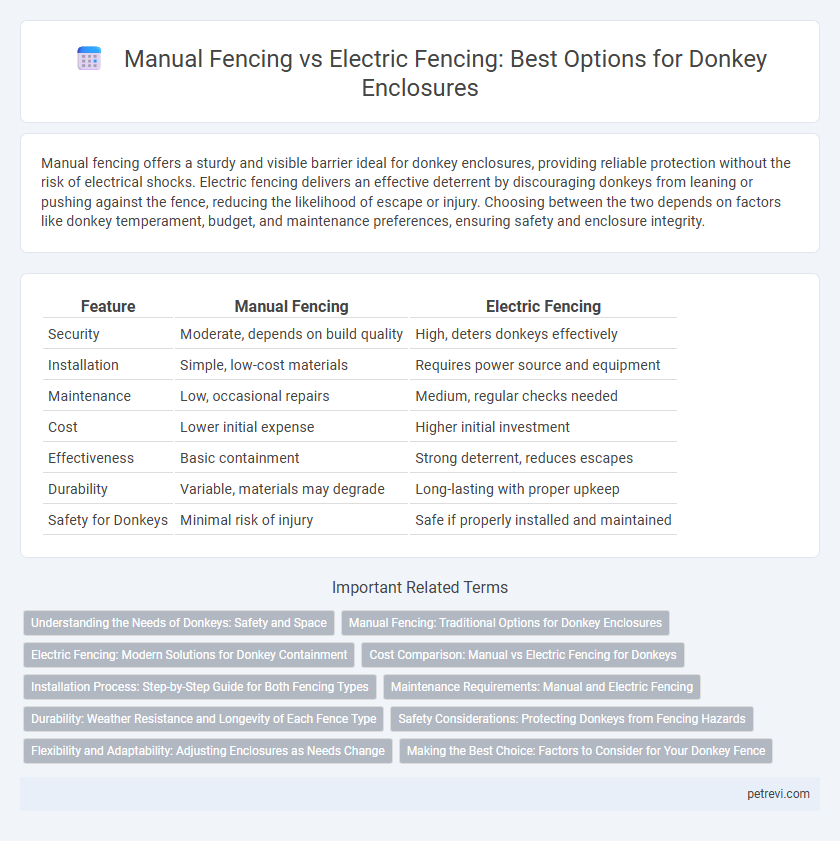Manual fencing offers a sturdy and visible barrier ideal for donkey enclosures, providing reliable protection without the risk of electrical shocks. Electric fencing delivers an effective deterrent by discouraging donkeys from leaning or pushing against the fence, reducing the likelihood of escape or injury. Choosing between the two depends on factors like donkey temperament, budget, and maintenance preferences, ensuring safety and enclosure integrity.
Table of Comparison
| Feature | Manual Fencing | Electric Fencing |
|---|---|---|
| Security | Moderate, depends on build quality | High, deters donkeys effectively |
| Installation | Simple, low-cost materials | Requires power source and equipment |
| Maintenance | Low, occasional repairs | Medium, regular checks needed |
| Cost | Lower initial expense | Higher initial investment |
| Effectiveness | Basic containment | Strong deterrent, reduces escapes |
| Durability | Variable, materials may degrade | Long-lasting with proper upkeep |
| Safety for Donkeys | Minimal risk of injury | Safe if properly installed and maintained |
Understanding the Needs of Donkeys: Safety and Space
Donkeys require secure and spacious enclosures that prioritize both safety and comfort, making fencing a critical factor in their well-being. Manual fencing offers sturdy physical barriers ideal for preventing injury due to its solid construction, while electric fencing provides flexibility and effective containment through controlled deterrents. Selecting the appropriate fencing type must balance the donkey's natural behavior, escape tendencies, and the need for a safe environment that reduces stress and injury risk.
Manual Fencing: Traditional Options for Donkey Enclosures
Manual fencing options for donkey enclosures typically include wooden post-and-rail, woven wire, and barbed wire fences, each offering varying levels of durability and safety. Wooden post-and-rail fences are favored for their strong visibility, reducing injury risk, while woven wire fences provide a secure barrier to prevent donkeys from escaping or predators from entering. Regular maintenance is essential to ensure structural integrity and prevent accidental harm to donkeys caused by broken or loose fencing components.
Electric Fencing: Modern Solutions for Donkey Containment
Electric fencing offers a modern and efficient solution for donkey enclosures, providing reliable containment with minimal maintenance compared to traditional manual fencing. Using low-voltage pulses, electric fences deter donkeys from attempting to escape without causing harm, ensuring their safety and reducing the risk of injury common with manual wire or wooden barriers. This innovative approach enhances durability, adaptability to various terrains, and cost-effectiveness, making electric fencing a preferred choice for donkey owners seeking secure, long-lasting enclosures.
Cost Comparison: Manual vs Electric Fencing for Donkeys
Manual fencing for donkey enclosures typically involves wood, wire, or metal posts, resulting in higher initial material and labor costs but minimal ongoing expenses. Electric fencing requires a lower upfront investment with easy installation and maintenance, yet it demands continuous energy costs and periodic repairs. Evaluating lifetime expenses, electric fencing often proves more cost-effective for large or frequently modified donkey paddocks.
Installation Process: Step-by-Step Guide for Both Fencing Types
Manual fencing installation for donkey enclosures involves setting sturdy wooden or metal posts firmly in the ground, attaching durable wire or mesh fencing by nailing or fastening with clips, and ensuring the fence height and spacing prevent donkey escapes. Electric fencing requires placing insulated posts at regular intervals, stringing highly conductive polywire or tape, connecting to a reliable energizer, and verifying grounding rods are properly installed to maintain a consistent electric current. Both methods demand precise measurement, secure fastening, and ongoing inspection to ensure the enclosure's safety and effectiveness for donkeys.
Maintenance Requirements: Manual and Electric Fencing
Manual fencing for donkey enclosures requires regular inspection for damages such as broken or rotting posts and loose wires, demanding consistent physical repairs to maintain security. Electric fencing involves less frequent physical maintenance but needs routine testing of the electrical system, including battery checks and vegetation clearance to prevent shorts. Both systems require vigilance, but electric fencing often reduces labor intensity while providing effective containment for donkeys.
Durability: Weather Resistance and Longevity of Each Fence Type
Manual fencing made from treated wood or galvanized steel offers strong durability with high resistance to weather conditions like rain and wind, ensuring long-term enclosure stability for donkeys. Electric fencing, constructed with weather-resistant polywire or aluminum wire and insulated posts, provides effective durability but may require regular maintenance to address potential damage from storms or corrosion. Overall, manual fencing typically outperforms electric fencing in longevity due to its robust materials, while electric fencing benefits from flexibility and ease of repair in diverse weather environments.
Safety Considerations: Protecting Donkeys from Fencing Hazards
Manual fencing poses fewer electrical risks, minimizing the chance of shocks and injuries to donkeys, making it a safer option for sensitive animals. Electric fencing requires careful installation and low voltage settings to prevent harm, with insulated wires and strategic placement reducing accidental contact. Regular maintenance and visual markers are essential to ensure donkeys recognize the boundaries, preventing stress and physical damage.
Flexibility and Adaptability: Adjusting Enclosures as Needs Change
Manual fencing offers easy flexibility for donkey enclosures, allowing quick adjustments and repositioning with minimal tools, which suits rapidly changing containment needs. Electric fencing provides adaptability through adjustable voltage and modular components, enabling customization for various donkey behavior and terrain challenges. Combining manual structures with electric elements enhances overall enclosure flexibility, ensuring secure and adaptable boundaries for donkeys.
Making the Best Choice: Factors to Consider for Your Donkey Fence
When choosing between manual fencing and electric fencing for a donkey enclosure, consider factors such as safety, durability, and ease of maintenance. Manual fencing offers sturdy physical barriers that prevent escapes and reduce injury risks, while electric fencing provides a cost-effective, flexible solution that deters donkeys without causing harm. Evaluate your donkey's temperament, property size, and budget to select the optimal fencing system that ensures secure containment and animal welfare.
Manual Fencing vs Electric Fencing for Donkey Enclosure Infographic

 petrevi.com
petrevi.com